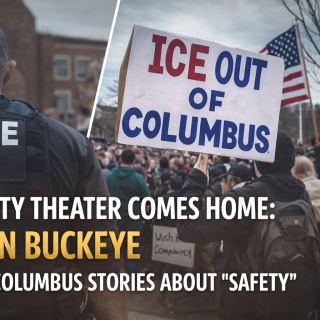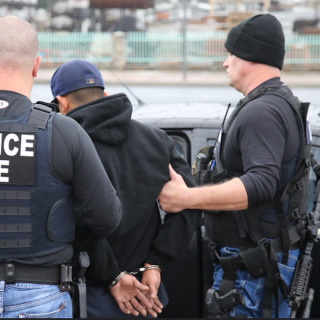Nazis disrupted a drag brunch on the Westside last week. Social media exploded over the news that white supremacists were disrupting a children’s event and were surprised by the inability of Columbus Division of Police to ensure the Nazis were barred from exposure and scaring the community with their black ski masks.
Up until a few weeks ago, when three Democratic lawmakers joined mostly young people at the Tennessee legislature demanding stricter gun legislation in the wake of yet another mass shooting, the First Amendment was sacrosanct: It states: “Congress shall make no law respecting an establishment of religion, or prohibiting the free exercise thereof; or abridging the freedom of speech, or of the press; or the right of the people peaceably to assemble, and to petition the Government for a redress of grievances.”
The supermajority GOP Tennessee legislature quickly voted to remove the two Black office holders and barely spared the one white legislator who joined them from removal. The legislators’ city governments found workarounds for these expulsions; but the moves made by the majority in this case suggests that whether or not Congress makes laws abridging these freedoms, their state counterparts will test those laws when their own interests are inconvenienced.
In the meantime, Columbus law enforcement has enabled hate speech while the power-mad factions of our state and local legislatures do whatever they can to curtail the collective power of the people: back in November, I drove past a Patriot Front banner hanging over a bridge on 4th Street. When I called the non-emergency police line to ask that it be taken down, first the officer over the phone claimed ignorance about who they were, then said that the banner was protected by the First Amendment.
(I don’t know who took the banner down, but it was gone by the time I passed by the intersection the next day. Apparently, someone figured out flying a banner for white supremacist propagandists isn’t a good look for a place claiming to be a “Unity City.”)
This week, the Ohio legislature will vote on HJR1, which increases the threshold for statewide petitions from a majority of 50% in the counties in the state to a majority of 60% of the same, making the formerly gargantuan task of getting measures onto the ballot our legislatures ignore but the people need nigh on impossible.
All of this goes on during an era where Columbus law enforcement continue to maim and kill Black people in this city with little to no consequence, our Democratic-controlled City and County governments either continue to enable the rogue forces under their purview or pretend that everything’s fine. This era also happens to see a marked increase in white supremacist/alt-right activities, answered by mixed responses on our side.
The isolation these mixed responses have created among otherwise allied leftist local groups – combined with the collective direct and vicarious trauma we all experience whenever we hear of another state-sanctioned lynching, absurdly draconian or intentionally ineffective legislation – has created strains among us that will cripple our efforts if we don’t address them.
Our oppressors and their allies have as many eyes and ears as we do. Every time we splinter, they rejoice. Every time we attack each other, they get stronger.
When we step back to examine trends, it’s easy to see that history repeats itself whether we’re cognizant of it or not: as Jim Crow laws in the south and corrupt police and the business infrastructure in the north systematically oppressed Black people across the country at the turn of the 20th century, the three major figures in that Movement were so busy attacking each other that they failed to exact the positive change each man knew we needed. None possessed enough humility to acknowledge that each played a pivotal role. Because of their competition rather than their cooperation coupled with the trauma brought about by their relative isolation and the compounded responsibility that isolation brought about, Booker T. Washington died at age 59 of kidney failure in 1915 and Marcus Garvey died in exile of two successive strokes at the age of 52 in 1940. Not to be outdone by the ideological rivals who should have been his partners, Dubois died in 1963 at the age of 95 – two years into a self-imposed exile in Nkrumah’s Accra, Ghana in 1963. “By the age of 50,” Dubois once quipped, “my death was practically requested.”
The day after Dubois died, 23-year-old John Lewis – newly-elected President of the Student Nonviolent Coordinating Committee (SNCC) – served as the opening act for Dr. Martin Luther King’s iconic I Have a Dream speech. Late that November, President John Kennedy was shot in the head and killed in Dallas, TX.
In response to the assassination, Malcolm X was quoted as saying that JFK’s assassination was a matter of the “chickens coming home to roost.” It’s just desserts, his assertion went, when the oppressors’ enablers are killed by the oppressors’ minions.
On February 21st, 1965, Malcolm was assassinated in Harlem, Manhattan, New York. In 1966, Lewis would be replaced by the more militant Stokely Carmichael, who would later change his name to Kwame Toure – in part to honor Ghanaian President Kwame Nkrumah. Two years later, on April 4th, 1968, Martin Luther King was assassinated by James Earl Ray in Memphis, TN.
Malcolm – re-named El Hajj Malik El Shabazz after his pilgrimage to Mecca in 1964 – was 39 when unverified assailants riddled his body with bullets. Well, not actually “unverified”: three members of Malcolm’s former church, the Nation of Islam, were convicted of his assassination in 1966. However, speculations about the assailants – and their backers – have been hotly debated since. The same is true of Martin’s assassination in ‘68 insofar as who ordered it: he was also 39 when James Earl Ray (allegedly?) shot and killed Dr. King. Two months and two days after he was shot, on June 5th, 1968, a Palestinian activist named Sirhan Sirhan allegedly put bullets into the back and head of the Senator. He died on June 6, 1968.
Near the end of the next year – Dec. 4th, 1969 – Deputy Chairman of the Chicago chapter of the Black Panther Party, 21-year-old Fred Hampton, would be massacred by Chicago police while he was lying in bed at 4 in the morning.
51 years later – December 4th, 2020 – Franklin County, Ohio Sherriff’s Deputy M. Jason Meade shot 23-year-old Casey Goodson, Jr., five times in the back and once in the buttock for allegedly pointing a gun at him right before Goodson parked his car and walked into his grandmother’s apartment. Goodson had earbuds in his ears at the time and was carrying Subway sandwiches to feed his family after a dental appointment.
51 years to the day that Senator Robert F. Kennedy died – June 6, 2016 – Henry Green V would be murdered by two CPD officers in the “Jump Out Boys” program. Henry Green was 23 when he was shot and killed by Columbus Police officers.
After conversations with Sirhan in his prison cell years after his father’s assassination, Sen. Kennedy’s son, representative Robert F. Kennedy Jr., said he did not believe that Sirhan had been the only shooter. RFK Jr. is also a prominent anti-vaxxer.
In July of 2020, I attended a counter-protest for an anti-vaccine, anti-mask rally held at the Ohio Statehouse lawn across from the Ohio Theatre. Early on during the Uprisings in protest of the murders of George Floyd in Minneapolis, Ahmaud Arbery in Atlanta, Breonna Tayolr in Louisville, and an average of 3 young Black people – usually male, often in the back, here in Columbus – a few of the front-panel glasses in the front of the theater had been broken. No one knows for sure who broke the glass – a few told me it had been the Fire Department – but nonetheless, having to board up those windows caused a certain amount of indignation from the people who hadn’t been downtown during that time and were extremely concerned about “looting” by Black Lives Matter and “Antifa” protestors – even though there’d been no evidence of said “looting” by any of the organizers and protestors then or since.
The anti-vaxxers who’d arranged the primary protest had enlisted 3 Percenters, Proud Boys, and Boogaloo Bois to act as security for their event. Two of those three groups’ national leadership are now either in trial or under investigation for their participation in the Jan. 6, 2021, Insurrection attempt.
The first easily verifiable time a member of the Columbus Police killed anyone under questionable circumstances (that I’ve been able to find) was when Fred Crews, who was 15 was shot and killed after an alleged robbery.
Ty’re King, 13, was shot in the back by a Columbus police officer in September of 2015. He was being chased after a failed robbery. A pellet gun was recovered from Ty’re’s body.
Donovan Lewis, 20, was shot while in bed during a late-night raid into his apartment at the end of August 2022. He was holding a vape pen in his left hand which the officer who shot him, Ricky Anderson, claimed looked like a weapon—much like the cell phone Andre Hill was holding when Adam Coy shot and killed him late at night a few days before Christmas of ’20.
In February of this year, a policeman who’d recently been re-instated for excessive force shot 66-year-old Michael Cleveland in the back, crippling him. Officer Joshua Ohlinger is still on the force.
In February of 2016, Marshawn McCarrell – who’d recently been awarded by the NAACP for his activism and organizing efforts – killed himself at the steps of the Ohio Statehouse.
His last two Facebook posts read “My demons won today. I am sorry” and “Let the record show that I pissed on the Statehouse before I left it.”
Late in the last legislative session last year, The Ohio Assembly passed and the governor signed Stand Your Ground into law.
In October of last year, 35-year-old Kreig Butler shot unarmed 13-year-old Sinzae Reed and killed him.
After a week in jail, he was released and his charges were dropped – Stand Your Ground was cited as the reason for Butler’s release and the case’s dismissal.
We cannot afford to quibble about personal, tactical or ideological differences on our side while the Radical Right amasses followers and domestic terrorist activities at a rate not seen in this country in a hundred years. We cannot afford to quibble about who might have insulted whom over social media while Nazis march in our streets protesting LGBT youth brunches and Proud Boys bully LGBT-friendly churches. We cannot afford to turn our noses up at each other’s lack of ideological purity about guns and policing while our teenagers are broiled in turf wars nobody but them seem to understand and law enforcement maims and kills us without consequence.
We cannot afford to quibble about ideology while we lose an activist to suicide or burnout for every three kids law enforcement kills in this city. (Yes—a 20-year-old is a “kid.”)
We cannot afford to quibble even in the face of history. All Movements are messy-- including ours. I believe, however, that we’ll learn from the lessons in the past and, if we take a longer view and understand that each of us has strengths, we can double those strengths in acknowledging who has which and when to use them.
We don’t have to repeat the mistakes of the past even while we continue to do so. We either learn our history, the saying goes, or we are doomed to repeat it.
None of this history is secret. The question is: how quickly and how deeply will we learn from it?




